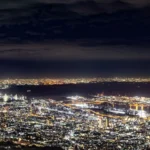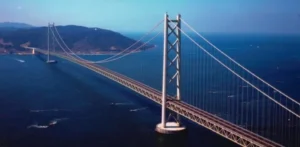
Contents
Overview
The Akashi Kaikyō Bridge, also known as the Pearl Bridge, is an architectural and engineering masterpiece connecting Kobe City on Japan’s main island (Honshu) with Awaji Island in the Seto Inland Sea. Completed in 1998, the bridge spans the Akashi Strait, one of Japan’s busiest and most challenging waterways, known for strong tides and heavy maritime traffic.
With a total length of 3,911 meters and a central span of 1,991 meters, it is recognized as the world’s longest suspension bridge. Its striking structure, cutting-edge engineering, and scenic location make it one of Japan’s most iconic landmarks.
Key Features
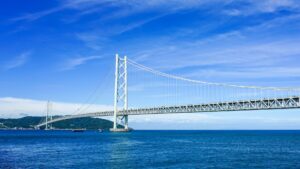
Record-Breaking Engineering
-
The central span of 1,991 meters remains the longest of any suspension bridge in the world.
-
The two main towers rise approximately 300 meters above sea level—taller than most skyscrapers.
-
The bridge was built to withstand severe natural forces, including:
-
Wind speeds up to 80 m/s (nearly typhoon strength)
-
Earthquakes measuring magnitude 8.5 or higher
-
Strong currents of the Akashi Strait, which reach up to 4.5 meters per second
-
A Bridge Built with Precision
-
Designed to last 200 years, incorporating advanced materials and structural monitoring systems.
-
Construction took 10 years, involving more than two million workers.
-
During construction, the 1995 Great Hanshin Earthquake shifted the towers 1 meter apart, and the final design was adjusted with remarkable accuracy.
Scenic Beauty

Panoramic Views
The bridge offers sweeping views of:
-
Kobe’s coastline
-
Awaji Island’s northern shore
-
The Seto Inland Sea, known for its deep blue water
-
Dramatic sunrises and sunsets over the strait
At night, the bridge is illuminated with approximately 1,600 LED lights, which change color according to season and special events, creating a stunning spectacle.
Maiko Marine Promenade – The Closest Viewpoint
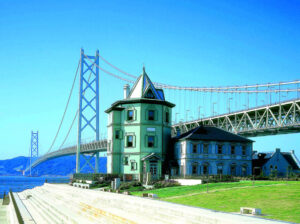
Visitors can explore the Maiko Marine Promenade, an enclosed walkway located inside the bridge’s truss structure, suspended 47 meters above sea level.
Highlights include:
-
Glass-floor observation panels that allow you to see the sea below
-
Exhibits explaining the bridge’s construction, engineering, and history
-
Viewing lounges with panoramic windows
-
Outdoor terraces offering unobstructed views of the strait and Awaji Island
Admission fee is required, and the experience is suitable for families, photographers, and engineering enthusiasts.
Bridge World Tour – Exclusive Access
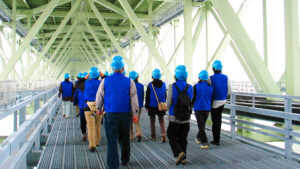
For those seeking a deeper experience, the “Bridge World Tour” allows visitors to climb inside the maintenance area and ascend to the top of the 300-meter tower.
This guided tour offers:
-
Up-close views of suspension cables and inner structures
-
A rare chance to stand on the tower’s summit platform
-
A 360-degree panoramic view of the Seto Inland Sea and Kobe cityscape
Advance reservations are required, and participants must meet certain age and clothing requirements.
Getting There
From Kobe (Sannomiya Station)
-
JR Kobe Line to Maiko Station (about 20 minutes)
-
Walk 5 minutes to the bridge and promenade entrance
From Osaka
-
JR Kobe Line from Osaka Station (approx. 45–50 minutes)
-
Transfer-free route to Maiko Station
Access to Awaji Island
-
Highway buses operate between Sannomiya, Osaka, or Tokushima and Awaji Island via the bridge.
-
Cars can cross the bridge using the Kobe-Awaji-Naruto Expressway.
Best Time to Visit
-
Daytime: Clear views of the sea and surrounding landscapes
-
Sunset: Golden-hour photography with dramatic lighting
-
Nighttime: Beautiful LED illumination across the entire span
Spring and autumn offer comfortable temperatures and excellent visibility.
Nearby Attractions
-
Maiko Park – A seaside park perfect for relaxing and photo opportunities
-
Former Residence of Sanji Muto – A Western-style house with historical significance
-
Sun Yat-sen Memorial Hall (Ijokaku) – A museum dedicated to the Chinese revolutionary leader
-
Awaji Island – Famous for nature, hot springs, flowers, and scenic drives
Travel Tips
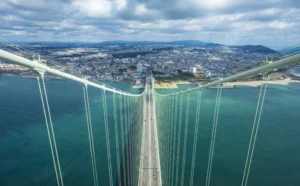
-
Wind conditions can be strong; bring a jacket even in warmer months.
-
Photographers should bring wide-angle lenses to capture the scale of the bridge.
-
Sunset viewing on weekends can be crowded, so arriving early is recommended.
-
The Maiko Marine Promenade may close during strong winds or storms.
Related articles
Official Website
https://www.jb-honshi.co.jp/english/bridgeworld/index.html
Great Accommodation Site
